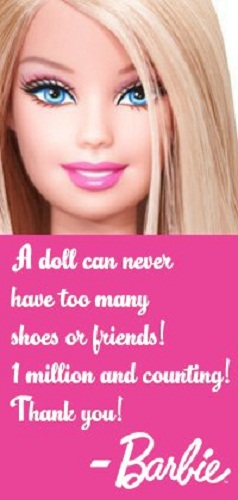
Marketing a Toy as an Icon
|
Since the beginning, Barbie has been presented as a beautiful and independent woman, the doll that every girl should want to be like. Perhaps the undying success of Barbie can be attributed to the fact that this myth has been maintained by Mattel for 52 years. As one scholar suggests, "Time has revealed Barbie to be far more than a doll. She is a brand identity" (Cannon 5). Though Barbie's clothes, physique, accessories, and friends have changed over the years to meet societal interests, the myths that surround Barbie have been preserved. This evolution of image and preservation of concept "must be managed throughout the life of the brand" (Park 137) in order to keep the demand of the product high. Although the Barbie ideology is often criticized, it has proven to be financially rewarding and often in a capitalist society, that is all that matters to producers like Mattel. Marxist analysts would refer to this as "profit-motive," defined as "the continuous desire to increase capital" (Ott 24). Though many companies deny this to be their sole motive, it is definitely the primary one. "For Marx, a society based on a capitalist mode of production is inherently exploitive" (Ott 23), and in the case of Barbie, those who are oppressed in society are the ones being exploited. Mattel makes millions of dollars each year by creating Barbie products that perpetuate hegemony. Recently, Mattel has partnered with other Western corporations like facebook, MAC cosmetics, and Volkswagon to promote their companies by combining their products and advertising. Rogers asserts that sustaining the Barbie brand requires a "dense web of products not only with Barbie and Mattel but also with other corporate sponsors and popular culture." (Rogers 95).
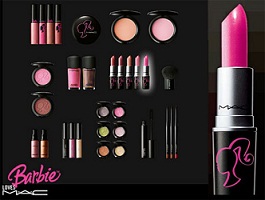    During the "Barbie loves MAC" campaign, MAC produced cosmetics that had a logo (shown above) portraying a hot pink outline of Barbie's profile, with the word MAC beside it. The combined effort of Mattel and MAC benefits both companies, because they work to enforce the same myths that sustain their businesses. Wolf's "beauty myth" is at work for both companies in this campaign. If women did not place a high value on being beautiful, they wouldn't buy cosmetics, especially those as expensive as MAC's. Similarly, if the beauty myth did not exist Barbie would cease to be an image of 'perfection.' In the image of Barbie and Ken above, Barbie dons dramatic pink eye make-up, and the lip print on Ken's check signifies that Barbie kissed him wearing pink lipstick. The image above to the far right shows a model whose make-up seems to be mirroring and accentuating that of Barbie's. Here, the model has become a "real" version of Barbie and Barbie has become made over by MAC. These ads work to promote their own company as well as their partner company, meaning that they can divide the advertising costs and increase profit even more. Currently, Facebook is one of the most popular and visited sites in America as well as many other countries. Among teenage and young adult crowds, it is very uncommon not to have a facebook. "In 1996, John Greenwald reported that 99 per cent of all girls in the United States between three and ten years old [had] at least one Barbie; the average girl [had] eight," and these statistics remain high today (Rogers 13). Facebook and Barbie are everywhere. They are unavoidable commodities that everyone "will know [enough] to suppose that in various ways [these companies] will infiltrate" the lives of all young consumers (Rogers 13).
This close up of Barbie's face shows her whiteness and beauty. Her blue eyes and pink lips become salient, surrounded by her light skin and hair. This photo is an example of how Mattel creates an ideology that white European-American beauty is superior to beauty of women who are of other ethnicities. Though Barbie has doll friends who are of a variety of ethnicities, she is white and she is the only one focused on in the mass media. This concentration on Barbie and concealment of her friends is a way in which Mattel reinforces "white imperialism," especially in the realm of beauty. This could attribute to the fact that when Rogers interviewed African-American students from low-income families many described Barbie 'beautiful,' 'slender,' 'pretty,' and an 'idol' (12.) These girls also confessed wanting to be Barbie, and especially possess the Barbie look (12). It is important to note that these girls are idolizing a Caucasian doll and wanting to look like her. They do not express these feelings about an African-American Mattel doll, because they have not been exposed to one as repeatedly as they have been to Barbie. In the facebook photo above, Barbie is making what Jewitt and Oyama call "contact" with her viewer, meaning that the subject in the image looks as though she is trying to establish a connection with the viewer (145). Creating this imaginary bond is a tactic used by advertisers to make their audience interested in the subject of thead. Facebook helps Mattel by advertising her page, which then advertises her merchandise and the myths and concepts that sustain her popularity. 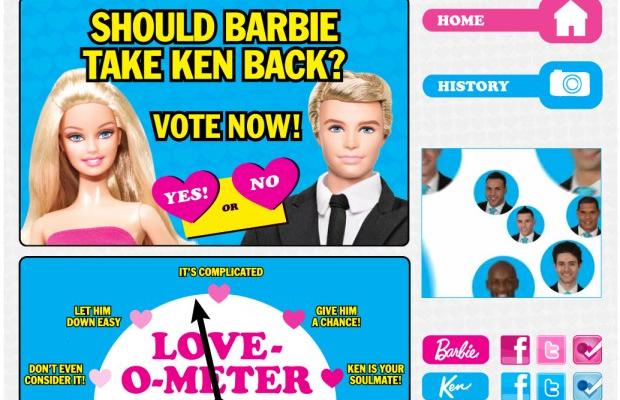 The image above is a web advertisement that appeared on Mattel's website this year before Ken and Barbie "reunited" on Valentine's Day. This ad gives consumers the option to vote on whether or not Barbie should "take Ken back." It also has links to both Barbie and Ken's facebook and twitter accounts. This ad uses a persuasive marketing strategy, in which Mattel gives consumers "agency" and lets them feel as though they have a say in how the Barbie & Ken narrative should play out. However, it appears that consumers were leaning toward "No," and it is likely that this advertisement was more a way of foreshadowing Barbie's decision to "take Ken back," and promote Mattel's presence on facebook and twitter than it was about giving Barbie fans agency. Though Facebook is definitely a gender-neutral site, here it is placed in a very gendered advertisement, because it appears in a Barbie ad, the ad over all seems to be targeting women. This can be inferred by the fact that Mattel normalizes heterosexuality in their "couple" stories, and in the right side of the ad there are images of attractive men. Though there are likely homosexual, transsexual, and bisexual fans of Barbie, Mattel operates as though they do not exist. This ad could also be called "feminine" because of the graphic images, such as the hearts, and the bright color scheme, which are both traditionally considered to be favored by women. Two consumer researchers named Jenny Lewin-Jones and Barbara Mitra conducted a study in which they interviewed children about their thoughts on different commercials that targeted children. They found that the children "associated certain product-types and colours with specific genders. For example, Harold (age 4) did not like the advertisements for Barbie dolls 'because they are for girls', although he liked 'the fighting ones' that were aimed at boys" (43). It is clear from this study that we begin to associate certain colors and behaviors as being "for girls" or "for boys" at a very young age, due to society's incessant use of these familiar correlations. For example, in hospitals, female babies are given pink hats and male babies are given blue as a way of easily identifying their sex. These same colors appear in the Barbie ad above, in which Barbie's name and websites appear in pink, and Ken's in blue. This cliche color scheme is hegemonic because it normalizes the gender binary by "color-coding" Barbie and Ken's websites, just as hospitals "color-code" their young charges.
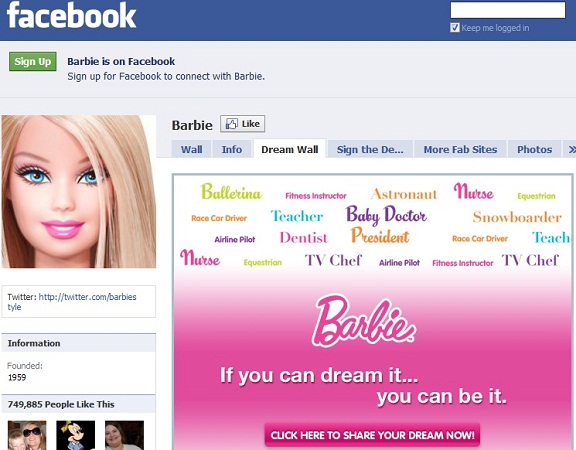 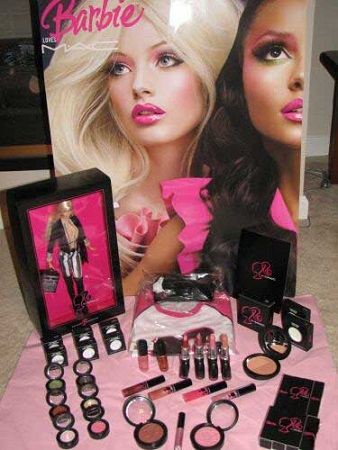 It is not surprising that Facebook and MAC would want to team up with Mattel, because Barbie is a cultural icon in America and, "[a]ccording to Mattel's president and chief executive officer Jill Barad, Barbie is nothing less than a 'global power brand'" (Rogers 86). This global influence is also present with Facebook, which is used as a tool to communicate and socialize, and is one way people can interact with each other across the globe for free, and because MAC employs the same myths that Mattel does, their partnership makes sense. "By virtue of the strategic plan, marketers can build on an image in a way that is consistent with the knowledge consumers already have acquired and enhance the duration of the brand's life cycle." (Park 139). These three companies are using this marketing tactic by linking themselves with other well-known brands, which will help them to extend their images to more audiences and maintain stability in the market. Although Barbie brings negative ideologies with her, Facebook and MAC are willing to ignore them, because profit is what drives most corporations, not ethics.
|
